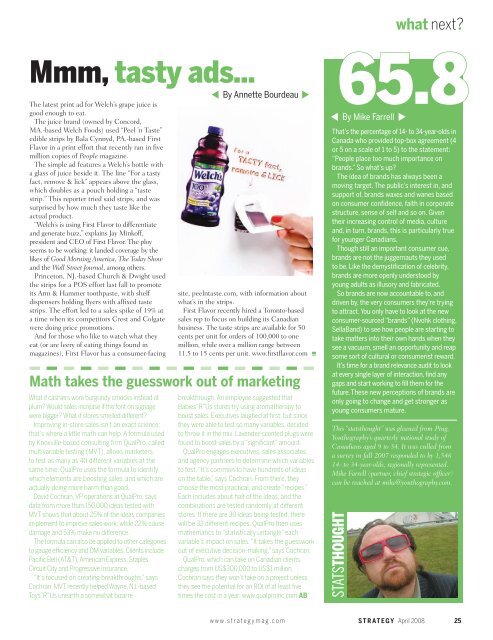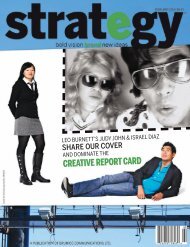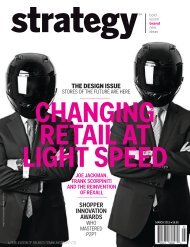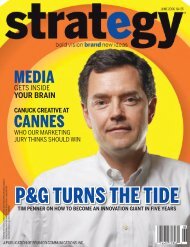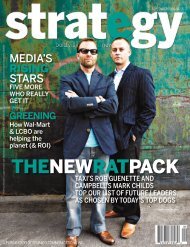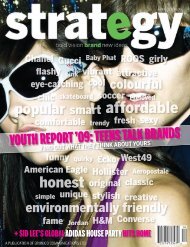Download PDF - Strategy
Download PDF - Strategy
Download PDF - Strategy
Create successful ePaper yourself
Turn your PDF publications into a flip-book with our unique Google optimized e-Paper software.
Mmm, tasty ads...<br />
The latest print ad for Welch’s grape juice is<br />
good enough to eat.<br />
The juice brand (owned by Concord,<br />
MA.-based Welch Foods) used “Peel ’n Taste”<br />
edible strips by Bala Cynnyd, PA.-based First<br />
Flavor in a print effort that recently ran in fi ve<br />
million copies of People magazine.<br />
The simple ad features a Welch’s bottle with<br />
a glass of juice beside it. The line “For a tasty<br />
fact, remove & lick” appears above the glass,<br />
which doubles as a pouch holding a “taste<br />
strip.” This reporter tried said strips, and was<br />
surprised by how much they taste like the<br />
actual product.<br />
“Welch’s is using First Flavor to differentiate<br />
and generate buzz,” explains Jay Minkoff,<br />
president and CEO of First Flavor. The ploy<br />
seems to be working: it landed coverage by the<br />
likes of Good Morning America, The Today Show<br />
and the Wall Street Journal, among others.<br />
Princeton, NJ.-based Church & Dwight used<br />
the strips for a POS effort last fall to promote<br />
its Arm & Hammer toothpaste, with shelf<br />
dispensers holding fl yers with affi xed taste<br />
strips. The effort led to a sales spike of 19% at<br />
a time when its competitors Crest and Colgate<br />
were doing price promotions.<br />
And for those who like to watch what they<br />
eat (or are leery of eating things found in<br />
magazines), First Flavor has a consumer-facing<br />
What if cashiers wore burgundy smocks instead of<br />
plum? Would sales increase if the font on signage<br />
were bigger? What if stores smelled different?<br />
Improving in-store sales isn’t an exact science:<br />
that’s where a little math can help. A formula used<br />
by Knoxville-based consulting firm QualPro, called<br />
multivariable testing (MVT), allows marketers<br />
to test as many as 40 different variables at the<br />
same time. QualPro uses the formula to identify<br />
which elements are boosting sales, and which are<br />
actually doing more harm than good.<br />
David Cochran, VP operations at QualPro, says<br />
data from more than 150,000 ideas tested with<br />
MVT shows that about 25% of the ideas companies<br />
implement to improve sales work, while 22% cause<br />
damage and 53% make no difference.<br />
The formula can also be applied to other categories<br />
to gauge efficiency and DM variables. Clients include<br />
Pacific Bell (AT&T), American Express, Staples,<br />
Circuit City and Progressive Insurance.<br />
“It’s focused on creating breakthroughs,” says<br />
Cochran. MVT recently helped Wayne, NJ.-based<br />
Toys“R”Us unearth a somewhat bizarre<br />
site, peelntaste.com, with information about<br />
what’s in the strips.<br />
First Flavor recently hired a Toronto-based<br />
sales rep to focus on building its Canadian<br />
business. The taste strips are available for 50<br />
cents per unit for orders of 100,000 to one<br />
million, while over a million range between<br />
11.5 to 15 cents per unit. www.fi rstfl avor.com<br />
Math takes the guesswork out of marketing<br />
65.8<br />
By Annette Bourdeau<br />
By Mike Farrell<br />
breakthrough. An employee suggested that<br />
Babies“R”Us stores try using aromatherapy to<br />
boost sales. Executives laughed at first, but since<br />
they were able to test so many variables, decided<br />
to throw it in the mix. Lavender-scented plugs were<br />
found to boost sales by a “significant” amount.<br />
QualPro engages executives, sales associates<br />
and agency partners to determine which variables<br />
to test. “It’s common to have hundreds of ideas<br />
on the table,” says Cochran. From there, they<br />
choose the most practical, and create “recipes.”<br />
Each includes about half of the ideas, and the<br />
combinations are tested randomly at different<br />
stores. If there are 30 ideas being tested, there<br />
will be 32 different recipes. QualPro then uses<br />
mathematics to “statistically untangle” each<br />
variable’s impact on sales. “It takes the guesswork<br />
out of executive decision-making,” says Cochran.<br />
QualPro, which can take on Canadian clients,<br />
charges from US$300,000 to US$1 million.<br />
Cochran says they won’t take on a project unless<br />
they see the potential for an ROI of at least five<br />
times the cost in a year. www.qualproinc.com AB<br />
That’s the percentage of 14- to 34-year-olds in<br />
Canada who provided top-box agreement (4<br />
or 5 on a scale of 1 to 5) to the statement:<br />
“People place too much importance on<br />
brands.” So what’s up?<br />
The idea of brands has always been a<br />
moving target. The public’s interest in, and<br />
support of, brands waxes and wanes based<br />
on consumer confidence, faith in corporate<br />
structure, sense of self and so on. Given<br />
their increasing control of media, culture<br />
and, in turn, brands, this is particularly true<br />
for younger Canadians.<br />
Though still an important consumer cue,<br />
brands are not the juggernauts they used<br />
to be. Like the demystification of celebrity,<br />
brands are more openly understood by<br />
young adults as illusory and fabricated.<br />
So brands are now accountable to, and<br />
driven by, the very consumers they're trying<br />
to attract. You only have to look at the new<br />
consumer-sourced “brands” (Nvohk clothing,<br />
SellaBand) to see how people are starting to<br />
take matters into their own hands when they<br />
see a vacuum, smell an opportunity and reap<br />
some sort of cultural or consumerist reward.<br />
It’s time for a brand relevance audit to look<br />
at every single layer of interaction, find any<br />
gaps and start working to fill them for the<br />
future. These new perceptions of brands are<br />
only going to change and get stronger as<br />
young consumers mature.<br />
This “statsthought” was gleaned from Ping,<br />
Youthography’s quarterly national study of<br />
Canadians aged 9 to 34. It was culled from<br />
a survey in fall 2007 responded to by 1,546<br />
14- to 34-year-olds, regionally represented.<br />
Mike Farrell (partner, chief strategic officer)<br />
can be reached at mike@youthography.com.<br />
STATSTHOUGHT<br />
www.strategymag.com STRATEGY April 2008<br />
25


